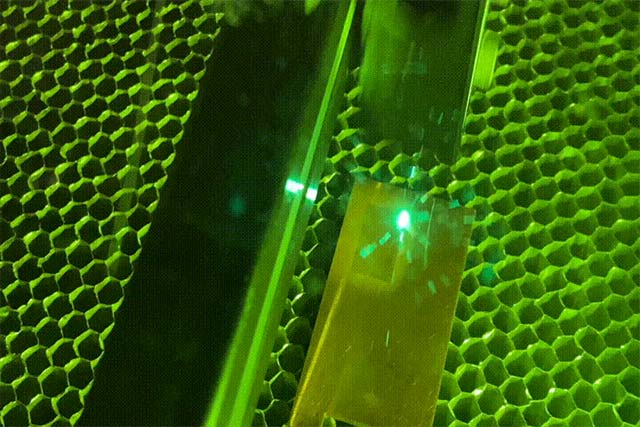This technology can turn metal surfaces into 'dead zones' with bacteria
As we know, bacterial pathogens can live on metal surfaces for days, especially in public areas like doorknobs, stair handrails, thus becoming a threat to public health.
Recently, Purdue University engineers have created a laser treatment that can turn any metal surface into a `` grim reaper '' that kills bacteria quickly by simply interfering with the structure. surface.
Specifically, according to research published in Advanced Materials Interfaces, the scientists have demonstrated that this technique allows the metal surface (in the experiment is copper) to immediately kill bacteria, including viruses like MRSA.
'Copper has been used as an antibacterial material for centuries. However under normal conditions, the natural copper surface takes hours to kill bacteria. To improve this, we have developed a laser-based molecular structure modification technique that enhances the effectiveness of bactericidal properties on copper surfaces', said associate professor of materials engineering Rahim. Rahimi, head of the research team said.
However, this technique has not been shown to kill viruses, such as the new strain of Corona virus that caused the COVID-19 pandemic, because they are much smaller in size than bacteria, and have the characteristics of Biology also has many differences.
Back on the issue of bacteria, Rahimi's team has now started testing the technology on the surfaces of different metals and polymers, with the goal of reducing the chances of bacterial growth, and establish a biofilm system on devices such as orthopedic implants or patches that can be used to kill bacteria in chronic wounds without antibiotics. In addition, this technique can also be applied to metal alloys known to have antibacterial properties.
 Laser surface treatment
Laser surface treatment Metals such as copper often have a very smooth surface, which greatly reduces the ability to kill bacteria. The technique developed by Rahimi's team uses lasers to create nano models on metal surfaces. These models will form a solid structure that increases the surface area, making bacteria more exposed to the metal surface, so that they will also be destroyed faster.
In fact, scientists have previously used different nanomaterial coatings to enhance the antibacterial properties of metal surfaces, but these coatings are easily broken and can be toxic to. environment. Rahimi's new method creates micron and nano samples directly on the target surface without changing most metal materials.
The dual-effect laser construction not only improves direct bacterial contact, but also makes the metal surface more 'hydrophilic'. In orthopedic implants, such surfaces allow bone cells to attach more strongly. Because of its simplicity and potential for future technological innovation, the researchers believe that it could easily be applied to existing medical device manufacturing processes.
You should read it
- See a $ 45,000 laser gun sweeping away all stains on metal in a flash
- Compare Microsoft Surface 3 and Surface Pro 3
- Surface Pro 3 receives new updates, improves drivers for the Surface Pen
- Successfully formulated, programmable, liquid metal fabrication that can conduct electricity
- Exotic metal knows 'transformations' back to the original shape no matter how deformed
- Surface Book 3 officially launched, becoming the most powerful Surface
- Take a look at the configuration of Microsoft Surface Book 3 based on the rumor series
- Detecting a series of vulnerabilities can help hackers disable metal detectors at airports
- Microsoft is developing a low-cost Surface computer running Windows 11 SE
- Microsoft: Surface Pro 3 sales exceeded expectations
- Inventing a bactericidal blue dye helps keep Ebola doctors safe
- Microsoft launched the first ad clip of the Surface Pro 3
May be interested

Facebook testing Quiet Mode to mute mobile app notifications

The system 'cleanup' application on Windows 10 will be upgraded

Google requires all devices released with Android 11 to support this feature

Using liquid metal instead of thermal paste, Asus laptops will be 10 to 20 degrees cooler than usual

Google Stadia Pro is free for 2 months

FAA says 737 Max needs additional computer changes






 The 'dead zone' on the ocean threatens the life and ecosystem of many seas
The 'dead zone' on the ocean threatens the life and ecosystem of many seas New discovery: Dragonfly wings can kill bacteria without antibiotics
New discovery: Dragonfly wings can kill bacteria without antibiotics Successfully formulated, programmable, liquid metal fabrication that can conduct electricity
Successfully formulated, programmable, liquid metal fabrication that can conduct electricity Get fever with new technology to identify E-coli bacteria
Get fever with new technology to identify E-coli bacteria Robots can recharge themselves by 'eating metal'
Robots can recharge themselves by 'eating metal' Exotic metal knows 'transformations' back to the original shape no matter how deformed
Exotic metal knows 'transformations' back to the original shape no matter how deformed